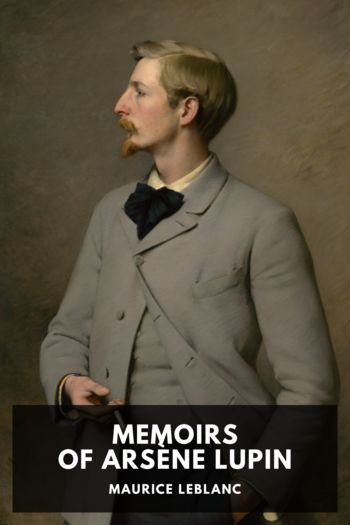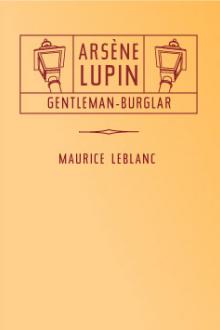The Confessions of Arsène Lupin, Maurice Leblanc [top 10 novels of all time txt] 📗

- Author: Maurice Leblanc
Book online «The Confessions of Arsène Lupin, Maurice Leblanc [top 10 novels of all time txt] 📗». Author Maurice Leblanc
At the same moment, an enormous motorcar, looking like some appalling monster, came tearing into sight at a headlong rate of speed. Amid the shouts of the madly scattering people, it made straight for the church, swerved, just as it seemed about to dash itself to pieces against the steps, grazed the wall of the presbytery, regained the continuation of the national road, dashed along, turned the corner and disappeared, without, by some incomprehensible miracle, having so much as brushed against any of the persons crowding the square.
But they had seen! They had seen a man in the driver’s seat, wrapped in a goatskin coat, with a fur cap on his head and his face disguised in a pair of large goggles, and, with him, on the front of that seat, flung back, bent in two, a woman whose head, all covered with blood, hung down over the bonnet. …
And they had heard! They had heard the woman’s screams, screams of horror, screams of agony. …
And it was all such a vision of hell and carnage that the people stood, for some seconds, motionless, stupefied.
“Blood!” roared somebody.
There was blood everywhere, on the cobblestones of the square, on the ground hardened by the first frosts of autumn; and, when a number of men and boys rushed off in pursuit of the motor, they had but to take those sinister marks for their guide.
The marks, on their part, followed the highroad, but in a very strange manner, going from one side to the other and leaving a zigzag track, in the wake of the tires, that made those who saw it shudder. How was it that the car had not bumped against that tree? How had it been righted, instead of smashing into that bank? What novice, what madman, what drunkard, what frightened criminal was driving that motorcar with such astounding bounds and swerves?
One of the peasants declared:
“They will never do the turn in the forest.”
And another said:
“Of course they won’t! She’s bound to upset!”
The Forest of Morgues began at half a mile beyond Saint-Nicolas; and the road, which was straight up to that point, except for a slight bend where it left the village, started climbing, immediately after entering the forest, and made an abrupt turn among the rocks and trees. No motorcar was able to take this turn without first slackening speed. There were posts to give notice of the danger.
The breathless peasants reached the quincunx of beeches that formed the edge of the forest. And one of them at once cried:
“There you are!”
“What?”
“Upset!”
The car, a limousine, had turned turtle and lay smashed, twisted and shapeless. Beside it, the woman’s dead body. But the most horrible, sordid, stupefying thing was the woman’s head, crushed, flattened, invisible under a block of stone, a huge block of stone lodged there by some unknown and prodigious agency. As for the man in the goatskin coat he was nowhere to be found.
He was not found on the scene of the accident. He was not found either in the neighbourhood. Moreover, some workmen coming down the Côte de Morgues declared that they had not seen anybody.
The man, therefore, had taken refuge in the woods.
The gendarmes, who were at once sent for, made a minute search, assisted by the peasants, but discovered nothing. In the same way, the examining-magistrates, after a close inquiry lasting for several days, found no clue capable of throwing the least light upon this inscrutable tragedy. On the contrary, the investigations only led to further mysteries and further improbabilities.
Thus it was ascertained that the block of stone came from where there had been a landslip, at least forty yards away. And the murderer, in a few minutes, had carried it all that distance and flung it on his victim’s head.
On the other hand, the murderer, who was most certainly not hiding in the forest—for, if so, he must inevitably have been discovered, the forest being of limited extent—had the audacity, eight days after the crime, to come back to the turn on the hill and leave his goatskin coat there. Why? With what object? There was nothing in the pockets of the coat, except a corkscrew and a napkin. What did it all mean?
Inquiries were made of the builder of the motorcar, who recognized the limousine as one which he had sold, three years ago, to a Russian. The said Russian, declared the manufacturer, had sold it again at once. To whom? No one knew. The car bore no number.
Then again, it was impossible to identify the dead woman’s body. Her clothes and underclothing were not marked in any way. And the face was quite unknown.
Meanwhile, detectives were going along the national road in the direction opposite to that taken by the actors in this mysterious tragedy. But who was to prove that the car had followed that particular road on the previous night?
They examined every yard of the ground, they questioned everybody. At last, they succeeded in learning that, on the Saturday evening, a limousine had stopped outside a grocer’s shop in a small town situated about two hundred miles from Saint-Nicolas, on a highway branching out of the national road. The driver had first filled his tank, bought some spare cans of petrol and lastly taken away a small stock of provisions: a ham, fruit, biscuits, wine and a half-bottle of Three Star brandy.
There was a lady on the driver’s seat. She did not get down. The blinds of the limousine were drawn. One of these blinds was seen to move several times. The shopman was positive that there was somebody inside.
Presuming the shopman’s evidence to be correct, then the problem became even more complicated, for, so far, no clue had revealed the presence of a third person.
Meanwhile, as the travellers had supplied themselves with provisions, it remained to be discovered what they had done





Comments (0)